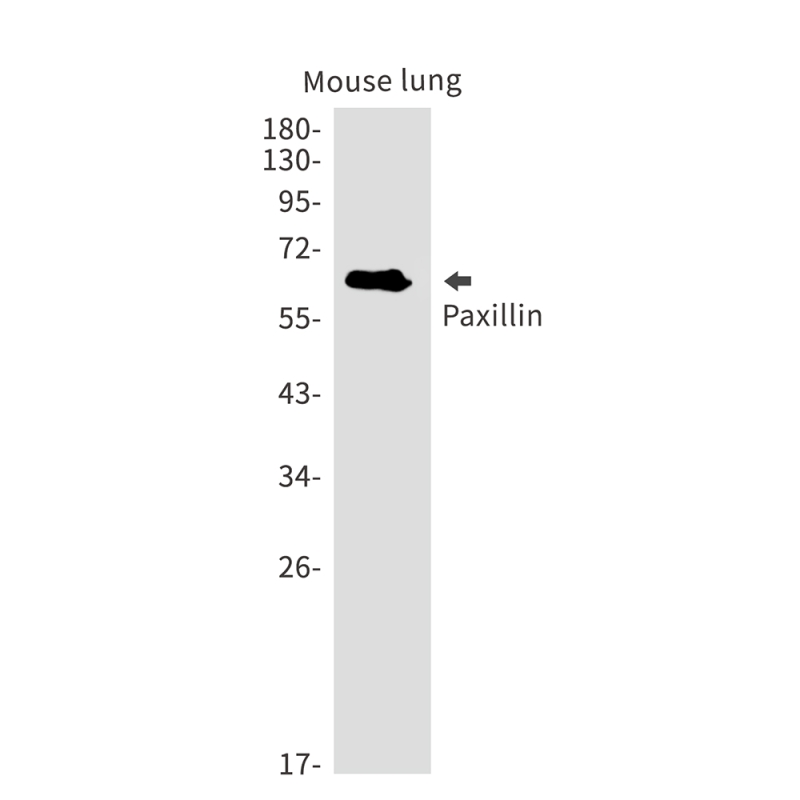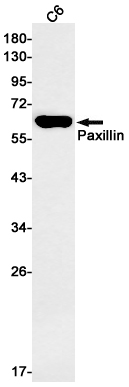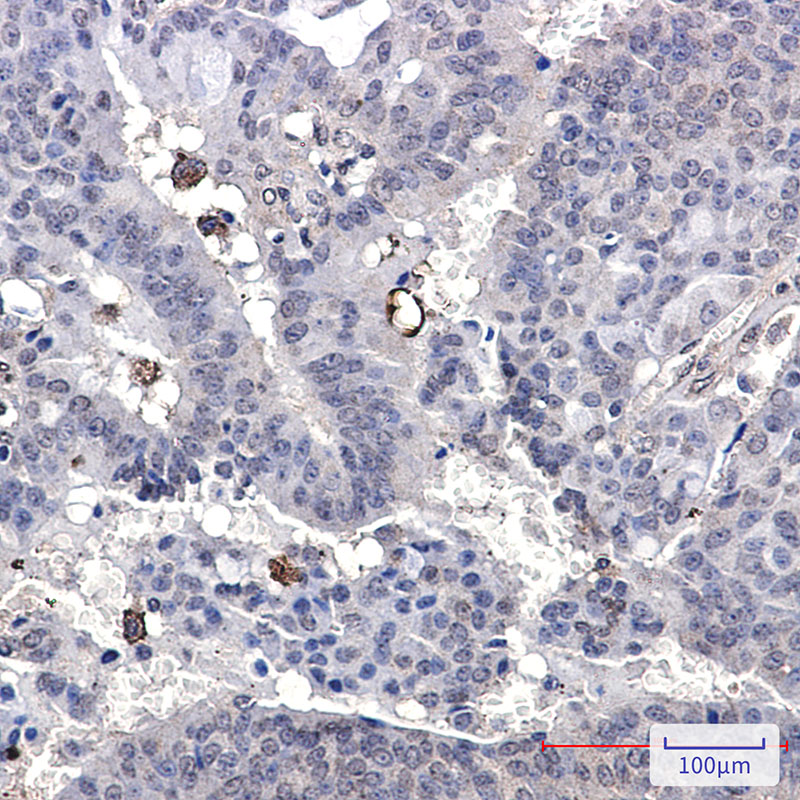



| WB | 1/500-1/1000 | Human,Mouse,Rat |
| IF | 1/20 | Human,Mouse,Rat |
| IHC | 1/50-1/100 | Human,Mouse,Rat |
| ICC | 1/50-1/200 | Human,Mouse,Rat |
| FCM | 咨询技术 | Human,Mouse,Rat |
| Elisa | 咨询技术 | Human,Mouse,Rat |
| Aliases | PXN; Paxillin |
| Entrez GeneID | 5829 |
| WB Predicted band size | Calculated MW: 65 kDa; Observed MW: 65 kDa |
| Host/Isotype | Rabbit IgG |
| Antibody Type | Primary antibody |
| Storage | Store at 4°C short term. Aliquot and store at -20°C long term. Avoid freeze/thaw cycles. |
| Species Reactivity | Human,Mouse,Rat |
| Immunogen | A synthetic peptide of human Paxillin |
| Formulation | Purified antibody in TBS with 0.05% sodium azide,0.05%BSA and 50% glycerol. |
+ +
以下是关于Paxillin抗体的3篇代表性文献及其摘要概括:
---
1. **文献名称**:*"Paxillin: A new vinculin-binding protein present in focal adhesions"*
**作者**:Turner CE, Glenney JR, Burridge K
**摘要**:该研究首次克隆并鉴定了Paxillin蛋白,揭示了其作为黏着斑关键衔接蛋白的功能。文中描述了特异性抗体的制备,并通过免疫荧光证实Paxillin与Vinculin共定位,阐明了其在细胞黏附中的作用。
2. **文献名称**:*"Paxillin phosphorylation sites regulate adhesion turnover and cell migration"*
**作者**:Brown MC, Perrotta JA, Turner CE
**摘要**:研究利用Paxillin磷酸化位点特异性抗体,发现Tyr31/Ser188位点的磷酸化调控黏着斑动态变化和细胞迁移。通过Western blot和活细胞成像,揭示了信号通路(如FAK/Src)如何通过修饰Paxillin影响肿瘤转移。
3. **文献名称**:*"Distinct roles of the adaptor protein Paxillin in normal and cancer cell migration"*
**作者**:Deakin NO, Turner CE
**摘要**:文章系统总结了Paxillin在细胞迁移中的双重作用,强调其抗体在检测亚细胞定位及表达水平中的应用。研究指出Paxillin在正常伤口愈合与癌症侵袭中的差异调控机制,为靶向治疗提供依据。
---
以上文献覆盖了Paxillin抗体的基础研究(克隆与定位)、功能机制(磷酸化调控)及疾病应用(癌症迁移),可作为相关实验的重要参考。
Paxillin is a multifunctional adaptor protein primarily localized at focal adhesions, dynamic structures that mediate cell-matrix interactions and regulate cell adhesion, migration, and signaling. It serves as a scaffolding platform, integrating signals from integrins, growth factor receptors, and cytoskeletal components to coordinate cellular responses to extracellular cues. Paxillin contains multiple protein-binding domains, including LD motifs and LIM domains, enabling interactions with kinases (e.g., FAK, Src), phosphatases, and cytoskeletal regulators. Its phosphorylation at specific tyrosine (e.g., Tyr31. Tyr118) or serine residues modulates protein interactions and downstream pathways involved in cell motility, survival, and mechanotransduction.
Paxillin antibodies are essential tools for studying focal adhesion dynamics and their roles in physiological processes (e.g., embryonic development, wound healing) and pathologies such as cancer metastasis, fibrosis, and cardiovascular diseases. These antibodies enable the detection of paxillin expression levels, post-translational modifications, and subcellular localization via techniques like Western blotting, immunofluorescence, and immunohistochemistry. Specific antibodies targeting phosphorylated isoforms help assess activation states of signaling pathways in response to mechanical or biochemical stimuli. Commercially available paxillin antibodies are typically raised against conserved regions or phosphorylation sites, with validation across species (human, mouse, rat) and applications. Their use has advanced understanding of how focal adhesion dysregulation contributes to disease progression, particularly in cancer cell invasion and drug resistance.
×